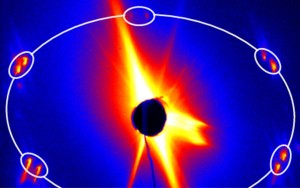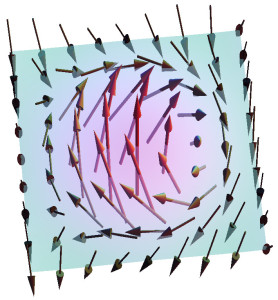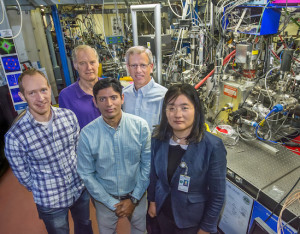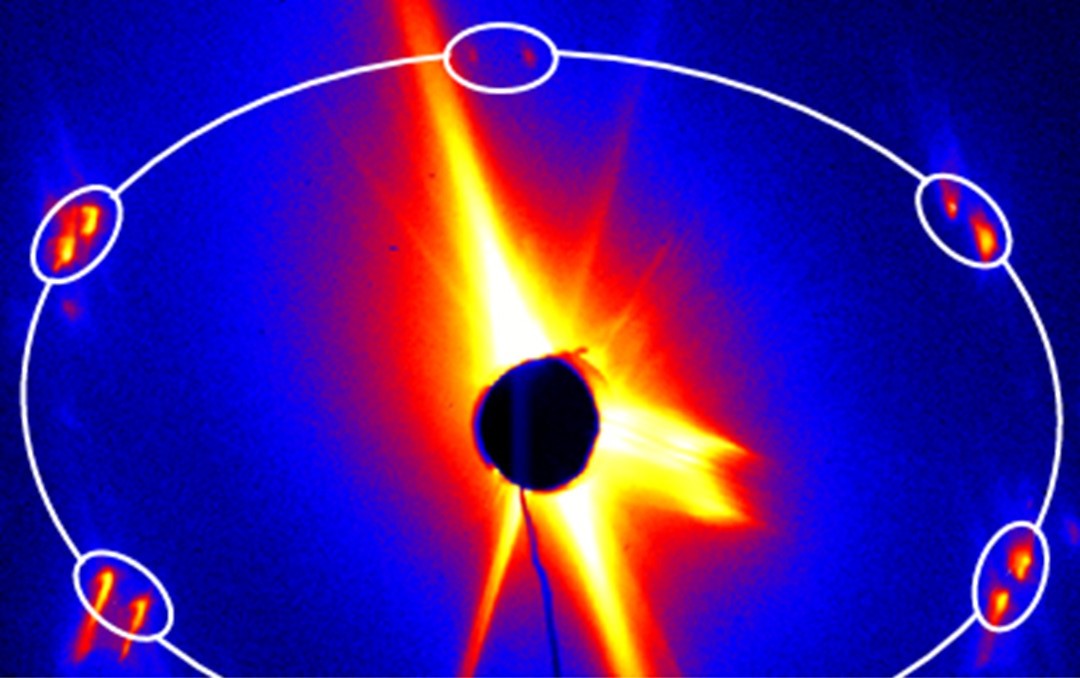
Advanced Light Source images of a Cu2SeO3 sample show five sets of dual-peak skyrmion structures, highlighted by the white ovals. The dual peaks represent the two skyrmion sub-lattices that rotate with respect to each other. All peaks fall on an arc (dotted line) representing the constant amplitude of the skyrmion wave vector.
Skyrmions, subatomic quasiparticles that could play a key role in future spintronic technologies, have been observed for the first time using x-rays. An international collaboration of researchers working at Berkeley Lab’s Advanced Light Source (ALS) observed skyrmions in copper selenite (Cu2SeO3) an insulator with multiferroic properties. The results not only hold promise for ultracompact data storage and processing, but may also open up entire new areas of study in the emerging field of quantum topology.
“Using resonant x-ray scattering, we were able to gather unique element-specific, orbital-sensitive electronic and magnetic structural information not available by any other method,” says Sujoy Roy, a physicist who oversees research at ALS Beamline 12.0.2 where the study was carried out, and the corresponding author of a paper describing this research in Physical Review Letters titled Coupled Skyrmion Sublattices in Cu2OSeO3.
“We found the unexpected existence of two distinct skyrmion sub-lattices that rotate with respect to each other, creating a moiré-like pattern,” Roy says. “Compared to materials with a simpler magnetic structure, the sub-lattices provide for an extra degree of freedom to minimize the free energy. This leads to magnetic excitations that can’t exist in materials with a single magnetic lattice structure.”

A skyrmion is an atom-sized whirlwind of magnetism, in which the spins of charged particles form a vortex. In this image the color scale – red for longer and blue for shorter vectors – shows that the magnetization is highest at the center of the skyrmion. (Image by Matthew Langner)
Although skyrmions act like baryons, they are actually magnetic vortices – discrete swirls of magnetism – formed from the spins of charged particles. Spin is a quantum property in which the charged particles act as if they were bar magnets rotating about an axis and pointing in either an “up” or “down” direction. The discovery of skyrmions – named for Tony Skyrme, a British physicist who first theorized their existence – in manganese silicide generated much excitement in the materials sciences world because their exotic hedgehog-like spin texture is topologically protected – meaning it can’t be perturbed. Add to this the discovery that skyrmions can be moved coherently over macroscopic distances with a tiny electrical current and you have a strong spintronic candidate.
“A major breakthrough came with the discovery of skyrmions in copper selenite because its magnetic properties can be controlled with an electric field,” says Roy. “To achieve this control, however, we must understand how different electron orbitals stabilize the skyrmionic phase. Until our study, the copper selenite skyrmions had only been observed with neutron scattering and transmission electron microscopy, techniques that are insensitive to electron orbitals.”
ALS Beamline 12.0.2 is an undulator beamline with experimental facilities optimized for coherent x-ray scattering studies of magnetic materials. The collaboration, which included researchers from Berkeley Lab’s Materials Sciences Division and Japan’s RIKEN institute, used these facilities to first identify the magnetic vortex. Then, at a certain applied electric field and temperature, they saw x-ray signals due to the formation of a skyrmion lattice.
“We were able to show that although the skyrmions act like magnetic particles, their origin in copper selenite is electronic,” says Matthew Langner, lead author of the Physical Review Letters paper. “We also found that temperature can be used to move the skyrmions in copper selenite in either a clockwise or counter-clockwise direction.”

From left, Matthew Langner, Stephan Kevan, Sujoy Roy, Robert Schoenlein and Xiaowen Shi were part of an international team of researchers that used the Advanced Light Source to provide new information on the quasiparticles known as skyrmions. (Photo by Roy Kaltschmidt)
Controlling the movement of skyrmions in a multiferroic compound suggests these magnetic vortices could be used to read and write data. Skyrmions are considered especially promising for the holographic information storage concept known as magnetic race-track memory.
“The skyrmion is topologically distinct from the other ground-state magnetic structures, meaning it can be moved around the sample without losing its shape,” Langner says. “The combination of this stability and the low magnetic and electric fields required for manipulating the skyrmions is what makes them potentially useful for spintronic applications.”
In addition to device applications, the collaboration’s findings show that is now possible to use x-rays to study spectroscopic and electronic aspects of the skyrmion, and to study skyrmion dynamics on the time-scale of fundamental interactions.
Co-authors of the Physical Review Letters paper, in addition to Roy and Langner, are Shrawan Mishra, James Lee, Xiaowen Shi, Muhammad Hossain, Yi-De Chuang, Shinichiro Seki, Yoshinori Tokura, Stephen Kevan and Robert Schoenlein.
This research was supported by the U.S. Department of Energy’s Office of Science.
Additional Information
For more about the Advanced Light Source go here
